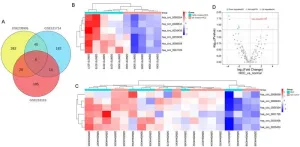(Press-News.org) In 2022, U.S. high school students Calcea Johnson and Ne'Kiya Jackson astonished teachers when they discovered a new way to prove Pythagoras’ theorem using trigonometry after entering a competition at their local high school. As a result, both students were awarded keys to the city of New Orleans, and even received personal praise from Michelle Obama.
Today they become published authors of a new peer-reviewed paper detailing their discoveries, published in the journal American Mathematical Monthly.
Pythagoras’ famous 2,000-year-old theorem, summarized neatly as a2 + b2 = c2, means that you can work out the length of any side of a right-angled triangle as long as you know the length of the other two sides. Essentially, the square of the longest side (the hypotenuse) is equal to the squares of the two shorter sides added together.
Many mathematicians over the years have proved the theorem using algebra and geometry. Yet proving it using trigonometry was long thought impossible, as the fundamental formulae of trigonometry are based upon the assumption that the Pythagorean Theorem is true – an example of circular reasoning.
Nevertheless, both Johnson and Jackson managed to solve the math problem independently of each other and prove Pythagoras’ theory without resorting to circular reasoning — a feat that has only been managed twice previously by professional mathematicians.
Johnson and Jackson then collaborated to share their work at a regional meeting of the American Mathematical Society in Atlanta in March 2023. Encouraged by their reception, Jackson and Johnson then decided to submit their discoveries for final peer review and publication. Their study outlines five new ways of proving the theorem using trigonometry, and a method that reveals five more proofs, totaling ten proofs altogether. Only one of these proofs was previously presented at the conference, meaning that nine are totally new.
“I was pretty surprised to be published” says Ne’Kiya Jackson. “I didn’t think it would go this far”.
“To have a paper published at such a young age — it's really mind blowing,” agrees Calcea Johnson.
“It’s very exciting for me, because I know when I was growing up, STEM [science, technology, engineering, and math] wasn't really a cool thing. So the fact that all these people actually are interested in STEM and mathematics really warms my heart and makes me really excited for how far STEM has come.”
In the paper, the authors argue that one of the reasons that trigonometry causes such confusion and anxiety for high school students is that two completely different versions of trigonometry exist and are defined using the same terms. This means that trying to make sense of trigonometry can be like trying to make sense of a picture where two different images have been printed on top of each other.
Jackson and Johnson argue that by separating the two versions, and focusing on just one of them, a large collection of new proofs of the Pythagorean Theorem can be found.
Jackson currently studies at Xavier University of Louisiana and is pursuing a doctoral degree in pharmacy, while Johnson is studying environmental engineering at Louisiana State University’s Roger Hadfield Ogden Honors College.
“I am very proud that we are both able to be such a positive influence in showing that young women and women of color can do these things, and to let other young women know that they are able to do whatever they want to do. So that makes me very proud to be able to be in that position,” says Johnson.
Commenting on Johnson and Jackson’s achievements, Della Dumbaugh, editor-in-chief of American Mathematical Monthly, says, “The Monthly is honored and delighted to publish the work of these two students on its pages.
“Their results call attention to the promise of the fresh perspective of students on the field. They also highlight the important role of teachers and schools in advancing the next generation of mathematicians.
“Even more, this work echoes the spirit of Benjamin Finkel when he founded the Monthly in 1894 to feature mathematics within reach of teachers and students of mathematics.”
END
Teens who made history with Pythagoras’ theorem discovery publish their first academic paper with new proofs
In their peer-reviewed work, Calcea Johnson and Ne'Kiya Jackson present five new ways of proving Pythagoras’ Theorem via trigonometry. They also detail a new method for finding proofs that yield at least five more
2024-10-28
ELSE PRESS RELEASES FROM THIS DATE:
More social species live longer, Oxford study finds
2024-10-28
UNDER EMBARGO UNTIL 00:01 GMT MONDAY 28 OCTOBER / 20:01 ET SUNDAY 27 OCTOBER 2024
More social species live longer, Oxford study finds
New research published today (28 Oct) from the University of Oxford has revealed that species that are more social live longer and produce offspring for a greater timespan. This is the first study on this topic which spans the animal kingdom, from jellyfish to humans.
What are the benefits and costs of sociality? Social organisms may enjoy benefits such as sharing resources, being better protected from predators, and having support to raise offspring. However, by living in more ...
Magicians don’t mind sharing the secrets behind tricks – if they are their own
2024-10-27
Magic is one of the oldest forms of entertainment, and much of its enchantment is said to rely on the audience not knowing how the tricks are done.
However, while magicians swear to keep their secrets forever when they embark on their profession they are happy to share the tricks of their trade in certain circumstances, a new study shows.
Illusionists who took part in major new research thought it was OK to expose their own techniques, but not those invented by others, and also believe it is acceptable to reveal the secrets behind tricks invented by someone who has since died.
They didn’t think it was right to share the workings of a magic trick just to gain public ...
No incentive for older birds to make new friends
2024-10-27
Like people, birds have fewer friends as they age, but the reasons why are unclear. New research suggests they may just have no drive to.
In humans, it’s often been assumed that older people have fewer friends because they’re pickier about who they spend their time with. There’s also the issue that there are fewer people of their own age around.
But it’s hard to pick apart the various potential causes for humans, so researchers have turned to animals. The team behind the new research, led by Imperial College London, studied an isolated population of sparrows on the island of Lundy, in the Bristol Channel.
By mapping the ...
Development and validation of a new prognostic model for predicting survival outcomes in patients with acute-on-chronic liver failure
2024-10-27
Background and Aims
Early determination of prognosis in patients with acute-on-chronic liver failure (ACLF) is crucial for optimizing treatment options and liver allocation. This study aimed to identify risk factors associated with ACLF and to develop new prognostic models that accurately predict patient outcomes.
Methods
We retrospectively selected 1,952 hospitalized patients diagnosed with ACLF between January 2010 and June 2018. This cohort was used to develop new prognostic scores, which were subsequently validated in external groups.
Results
The study included 1,386 ACLF patients and identified six independent ...
Identification and validation of the Hsa_circ_0001726/miR-140-3p/KRAS axis in hepatocellular carcinoma based on microarray analyses and experiments
2024-10-27
Background and Aims
Hepatocellular carcinoma (HCC) is one of the most fatal malignancies. Epigenetic mechanisms have revealed that noncoding RNAs, such as microRNAs (miRNAs) and circular RNAs (circRNAs), are involved in HCC progression. This study aimed to construct a circRNA-miRNA-mRNA network in HCC and validate one axis within the network.
Methods
HCC-related transcriptome data were obtained from the Gene Expression Omnibus, and HCC-related genes were sourced from GeneCards to identify differentially expressed circRNAs and miRNAs. ...
New study warns that melting Arctic sea-ice could affect global ocean circulation
2024-10-27
“Our finding that enhanced melting of Arctic sea-ice likely resulted in significant cooling in northern Europe in the earth’s past is alarming,” says Mohamed Ezat from the iC3 Polar Research Hub, lead author of the new study. “This reminds us that the planet’s climate is a delicate balance, easily disrupted by changes in temperature and ice cover.”
Ice-free summer conditions are expected to occur in the Arctic Ocean from the year 2050 onwards.
Earlier this ...
Researchers test imlifidase enzyme versus plasma exchange in removing donor-specific antibodies in kidney transplant rejection trial
2024-10-27
San Diego, CA (October 26, 2024) — For kidney transplant recipients experiencing antibody-mediated rejection, the current standard of care involves removing donor-specific antibodies (DSAs) through plasmapheresis (PLEX)—a procedure that removes antibodies from the plasma portion of the blood. Results from a recent clinical trial reveal that an investigational drug called imlifidase, which cleaves and inactivates the type of antibodies that include DSAs, is more effective than PLEX. The research will be presented at ASN Kidney ...
Preclinical studies test novel gene therapy for treating IgA nephropathy
2024-10-26
San Diego, CA (October 26, 2024) — IgA nephropathy is an autoimmune kidney disease, and complement, a component of the innate immune system, plays a role in the condition’s pathogenesis. Investigators have developed and tested a novel gene therapy that enters kidney cells and enables them to block complement activation. The research will be presented at ASN Kidney Week 2024 October 23– 27.
The gene therapy, called PS-002, uses a modified virus to treat kidney cells called podocytes. Administration of PS-002 in a mouse model of IgA nephropathy reduced signs of kidney dysfunction, lowered complement ...
Trial assesses antibody therapy for chronic active antibody-mediated kidney transplant rejection
2024-10-26
San Diego, CA (October 26, 2024) — Chronic active antibody-mediated rejection (caAMR) is a common cause of allograft loss after transplantation, with no approved therapies. Clazakizumab, a monoclonal antibody that targets the inflammatory cytokine interleukin-6 (IL-6), stabilized kidney transplant recipients’ kidney function in a phase 2 trial. Investigators now have data from a phase 3 trial with clazakizumab. The findings from the Phase 3 IMAGINE trial, the largest placebo-controlled study in kidney transplant recipients with caAMR, will be ...
High-impact clinical trials generate promising results for improving kidney health: Part 2
2024-10-26
The results of numerous high-impact phase 3 clinical trials that could affect kidney-related medical care will be presented in-person at ASN Kidney Week 2024 October 23–27.
Hyponatremia, or a chronically low blood salt level, is the most common electrolyte disorder in hospitalized patients, and is associated with higher risks of death and re-hospitalization. In a recent trial, 2,173 hospitalized patients with hyponatremia from 9 centers across Europe were assigned to undergo either targeted correction of blood salt levels according to guidelines or to receive routine care for hyponatremia. The primary outcome was the combined ...
LAST 30 PRESS RELEASES:
The Ceramic Society of Japan’s Oxoate Ceramics Research Association launches new international book project
Heart-brain connection: international study reveals the role of the vagus nerve in keeping the heart young
Researchers identify Rb1 as a predictive biomarker for a new therapeutic strategy in some breast cancers
Survey reveals ethical gaps slowing AI adoption in pediatric surgery
Stimulant ADHD medications work differently than thought
AI overestimates how smart people are, according to HSE economists
HSE researchers create genome-wide map of quadruplexes
Scientists boost cell "powerhouses" to burn more calories
Automatic label checking: The missing step in making reliable medical AI
Low daily alcohol intake linked to 50% heightened mouth cancer risk in India
American Meteorological Society announces Rick Spinrad as 2026 President-Elect
Biomass-based carbon capture spotlighted in newly released global climate webinar recording
Illuminating invisible nano pollutants: advanced bioimaging tracks the full journey of emerging nanoscale contaminants in living systems
How does age affect recovery from spinal cord injury?
Novel AI tool offers prognosis for patients with head and neck cancer
Fathers’ microplastic exposure tied to their children’s metabolic problems
Research validates laboratory model for studying high-grade serous ovarian cancer
SIR 2026 delivers transformative breakthroughs in minimally invasive medicine to improve patient care
Stem Cell Reports most downloaded papers of 2025 highlight the breadth and impact of stem cell research
Oxford-led study estimates NHS spends around 3% of its primary and secondary care budget on the health impacts of heat and cold in England
A researcher’s long quest leads to a smart composite breakthrough
Urban wild bees act as “microbial sensors” of city health.
New study finds where you live affects recovery after a hip fracture
Forecasting the impact of fully automated vehicle adoption on US road traffic injuries
Alcohol-related hospitalizations from 2016 to 2022
Semaglutide and hospitalizations in patients with obesity and established cardiovascular disease
Researchers ‘listen in’ to embryo-mother interactions during implantation using a culture system replicating the womb lining
How changing your diet could help save the world
How to make AI truly scalable and reliable for real-time traffic assignment?
Beyond fragmented markets: A new framework for efficient and stable ride-pooling
[Press-News.org] Teens who made history with Pythagoras’ theorem discovery publish their first academic paper with new proofsIn their peer-reviewed work, Calcea Johnson and Ne'Kiya Jackson present five new ways of proving Pythagoras’ Theorem via trigonometry. They also detail a new method for finding proofs that yield at least five more




